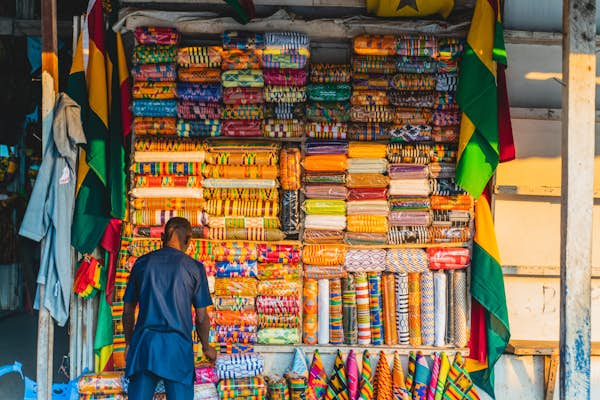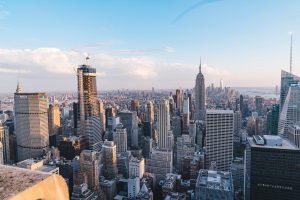
Being just a few degrees north of the equator, Ghana has an average temperature that remains balmy all year.
Its mild tropical climate boasts two distinct seasons: wet and dry. Both of them offer their own perks and setbacks. The wet season is an excellent time to visit the country’s north because the heat can be stifling the rest of the year, but it’s the dusty dry season that offers the region’s best wildlife viewing. As a general rule, Ghana’s mildest temperatures occur at higher elevations, such as in the Ashanti Uplands, with humidity clinging to the coastline in places like Accra and the Cape Coast. The farther north you go, the hotter and drier it gets.
Whenever you decide to visit Ghana, you’ll always find plenty of fantastic experiences, including a calendar of colorful festivals that’s one of the country’s distinct calling cards. Season by season, month by month, here is our guide to the best times to visit Ghana.
Make the most out of every adventure with help from our weekly newsletter delivered to your inbox.
December to March is the best time for wildlife and festivals
Ghana’s high season is also its dry season, which runs from November to March. With little to no rainfall, it’s fairly easy to travel across the country via Ghana’s network of well-maintained roadways.
These months are an especially good time to visit the country’s south, including the capital city of Accra. In fact, many Accra residents claim December is the best month to visit, with the holidays in full swing and festivals such as Afrochella – a celebration of African music, fashion, art and culture – kicking up the celebratory feel. One recurring event to keep an eye out for year round is the Ashanti Akwasidae festival held in Kumasi. It takes place every sixth Sunday based on the Ashanti calendar and includes loads of drumming and dancing, along with an impressive procession of the Ashanti king and his entourage.
Although the air can be quite dusty and dry in this season – the result of Saharan winds that blow across West Africa into the Gulf of Guinea – the rains are few, humidity is lower (meaning fewer mosquitos) and the temperatures are cooler, if only by a small (but very noticeable) degree.
Harmattan is the name for these cool, dry winds, which cause hazy skies, not to mention dry skin, eyes and throats. Lather on some locally made shea butter to keep your skin moisturized, and be aware that the overcast skies can make photography less than stellar. The winds can also cause flight delays or cancellations because of poor visibility, most notably in and out of Tamale, in Ghana’s north.
Ghana’s dry season remains the best time of the year for wildlife sightings, especially from December to March, the country’s driest months. This is when you’ll find the elephants of Mole National Park and other reserves gathering around any remaining watering holes, with a more barren landscape making it easier to spot monkeys, hyenas and buffalos.
March is typically Ghana’s hottest month, though rains can occur (and provide a cooling respite) at any time.
 Colorful festivals take place throughout Ghana during the harvest and dry seasons © Yaayi / Shutterstock
Colorful festivals take place throughout Ghana during the harvest and dry seasons © Yaayi / Shutterstock
September to November means harvest festivals and smaller crowds
While they’re still a part of the rainy season, September and October are when most travelers from Europe and North America have already come and gone, and the country’s harvest festivals are starting up. This is an ideal time to visit Ghana’s north, which has been consistently cooled by rains. By November, the rains have stopped in the south, but the Sahara winds haven’t quite kicked in. All three months are a good time to visit for those looking for smaller crowds, relatively decent weather and ample events.
April to August is the rainy season and popular with vacationers from Europe and North America
The low season in Ghana is the wet season, a time that can be humid and sticky, but with cooler temperatures and a lush explosion of greenery. Rains can consist of anything from a passing shower to a days-long monsoon.
Inland travels can be restricted during this time because of flooded roadways, but there’s still plenty to see and do in the country’s outer regions.
In Ghana’s southern half, April, May and June are some of the wettest months of the year. The rains then abate slightly through July and August (though showers are still common) before starting back up in September and into October. With relatively clear skies and ample greenery, this is a good time for photography. Up in the country’s north, the rains are continuous and can cool temperatures down, making the weather more bearable. However, this is also when mosquitoes are most frequent, so be sure to take extra precaution.
Even though these rainy months are Ghana’s low season, the country still sees an increase of European and North American travelers between June and August (Ghana’s coolest month), so book your flights and accommodations early.
 It’s easier to spot wildlife during Ghana’s dry season, particularly December to March © Frans Lanting / Getty Images
It’s easier to spot wildlife during Ghana’s dry season, particularly December to March © Frans Lanting / Getty Images
Spot wildlife in January
As the Harmattan winds rear their dusty head, January has the least rainfall in the country overall. Wildlife sightings are abundant.
Key event: Edina Bronya.
Keep the binoculars handy in February
The Harmattan winds remain active, as does the wildlife, which tends to crowd around watering holes in places like Mole National Park.
Key event: Dzawuwu.
It’s very hot in Ghana in March
March is Ghana’s hottest month, though the rains can begin anytime. The north also experiences squalls: strong, sudden winds that only last for a few minutes.
Key event: Independence Day.
 By the end of the dry season, Ghanaians are eagerly awaiting the rains © Gerhard Pettersson / Shutterstock
By the end of the dry season, Ghanaians are eagerly awaiting the rains © Gerhard Pettersson / Shutterstock
The rains finally arrive in April
April marks the official start of the wet season and Ghana’s low season. Heavy rains can often wash out roads, especially in the central part of the country, though reliable infrastructure makes most roads safe to travel.
Key event: Dipo.
Days are wet and temperatures are cooler in May
Rains are typically heavy in May, especially in the country’s center and south. Temperatures are a bit cooler as well.
Key event: Aboakyir.
Accra gets busier in June
Typically Ghana’s wettest month and still the low season, June is also when travelers from Europe and North America start arriving for their summer vacations, making cities like Accra especially busy.
Key event: Dzimbi Festival.
The north is cooler in July
The rain often takes a break in southern Ghana in July, and tourism from Western countries remains high. It’s a good time for visiting both Ghana’s northern and southern regions because the weather is a bit cooler up north, and days are typically warm and dry in areas like Accra and the Cape Coast.
Key events: Republic Day, Bakatue Festival, PANAFEST.
August is Ghana’s coldest month
Although the rains remain on standby in southern Ghana, August is traditionally the country’s windiest and coldest month. European and American tourists are still here in droves, and PANAFEST typically continues into the month in odd-numbered years.
Key events: Chale Wote Street Art Festival, Homowo.
 Colorful processions are a hallmark of Ghana’s many annual festivals, including Fetu Afahye on the Cape Coast © MyLoupe / Getty Images
Colorful processions are a hallmark of Ghana’s many annual festivals, including Fetu Afahye on the Cape Coast © MyLoupe / Getty Images
Celebrate the harvest in September
Most Western travelers have dispersed in September, and although the rains have started back up again in the south, it’s time for the harvest festivals to begin. Up north the rains continue, but the air is cooler and more tolerable than in other months.
Key event: Fetu Afahye.
October is one of the best times to visit
Ghana’s overall climate remains cooler and less humid, and the Harmattan winds are still a ways off. Harvest festivals are in full swing, and the rains have essentially stopped in southern Ghana and are winding down in the north. October is a great month to visit.
Key event: Ngmayem.
The fair weather continues all across Ghana in November
November is another good month to visit. The rains dissipate in the south and end in the north, and the weather is still relatively cool and less humid. The Harmattan winds are getting ready to blow, but they often have yet to arrive.
Key event: Hogbetsotso.
Join the returning Ghanaian diaspora in December
As the Ghanaian diaspora flies home to celebrate Christmas, December sees lots of celebrating and merrymaking, though some shops are closed so that families can be together. For a local feel, December is a good month to visit. While the Sahara winds have most likely picked up, so have the wildlife sightings in the north, as more animals make their way toward the limited number of watering holes.
Key events: Farmers’ Day, Christmas, Afrochella.



